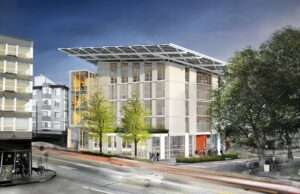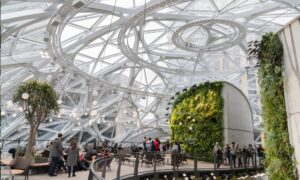Two decades ago, Philip Ross and Jeremy Myerson launched WORKTECH at the British Library, creating a global platform where leaders in people, place, and technology could come together to explore and shape the future of work. What began as a pioneering event has evolved into a worldwide series, with over 40 editions bringing together professionals from global companies to take a holistic approach to workplace innovation. Through this journey, WORKTECH has witnessed firsthand the changes, trends, and breakthroughs reshaping workplaces.
In this new blog, Around the World with WORKTECH, we’re following these conferences around the globe to spotlight the most innovative and forward-thinking workspaces in each host city.
Seattle, the first host city in this series, has been renowned as a hub of tech and innovation. However, our research into its workspaces revealed something unique about Seattle’s approach. In exploring the work environments of companies like Amazon, Qualtrics, and the revolutionary Bullitt Centre, a consistent theme emerged: Seattle workplaces don’t just adapt to the future, they’re actively building one that’s sustainable. While this series covers workplace innovation in many cities, Seattle is impressive because of its unique synergy between technological advancement and environmental responsibility.
Seattle’s Leading Workspaces: A Blend of Innovation and Sustainability
Seattle’s commitment to sustainability is evident in its leading workplaces, where innovative design meets with environmental responsibility. For example, the Bullitt Centre, one of the greenest commercial buildings in the world, sets a new standard for sustainable workplaces. Designed to be self-sufficient, the building produces its own energy through solar panels and captures rainwater for all its water needs. With its net-zero energy and water use, the Bullitt Centre is a model for eco-friendly construction and workplace design.
Its open-plan workspaces, natural lighting, and focus on environmental responsibility create an inspiring and health-conscious environment for its tenants. The Bullitt Centre demonstrates how workplaces can be designed to positively impact both people and the planet, serving as a blueprint for the future of sustainable office spaces.
Qualtrics Tower, the host venue for WORKTECH Seattle, also exemplifies this blend of innovation and sustainability. The tower features a unique design with a hero path—a dynamic quarter-mile journey that promotes movement and fosters spontaneous interactions among employees. This design choice not only enhances employee connection but also incorporates sustainable materials, including repurposed furniture and eco-friendly building elements. Qualtrics Tower demonstrates how innovative design can create a workspace that is both functional and environmentally responsible.

Bullitt Centre
Biophilic Design and Natural Element Incorporation
A distinctive aspect of Seattle’s approach to sustainability is the emphasis on biophilic design, integrating nature into the workplace to enhance employee well-being. The Amazon Spheres are a prime example, housing over 40,000 plants within their interconnected glass domes. This innovative workspace includes a garden-like environment that promotes creativity, reduces stress, and enhances productivity. By bringing nature indoors, Amazon exemplifies a pioneering approach that acknowledges the impact of the natural world on employee health.
Similarly, the Expedia Group Campus emphasises its connection to nature through its biophilic design. Situated on Seattle’s waterfront, this 40-acre campus incorporates rain gardens, meadows, and outdoor pavilions, encouraging employees to engage with their natural surroundings. The campus not only blurs the line between corporate and community spaces but also reinforces Expedia’s commitment to sustainability with features such as a rainwater absorption system and extensive green areas.

Amazon Spheres
Flexibility and Circular Economy in Seattle’s Workplaces
Flexibility is another critical theme in Seattle’s workplaces, particularly regarding their commitment to the circular economy. Companies are designing spaces that are adaptable and promote longevity, minimising waste while enhancing employee experience. Microsoft’s Redmond Campus, for instance, is undergoing a multi-billion-pound redevelopment focused on creating smart buildings that enhance productivity while prioritising sustainability. The campus incorporates geothermal energy and advanced technologies to significantly reduce energy consumption, showcasing how flexibility and sustainability can go hand in hand.
The design of shared spaces, modular layouts, and multipurpose meeting areas further proves this commitment. Seattle’s workplaces are increasingly adopting configurations that support hybrid work models while maintaining an eco-conscious mindset. This adaptability allows for a more collaborative and resource-efficient approach to modern work environments.
Why Seattle’s Model Matter
The innovative workplaces we’ve explored, from the Bullitt Centre’s sustainability efforts to the biophilic elements of Amazon’s Spheres and the adaptability of Microsoft’s Redmond Campus, demonstrate how companies in Seattle are pushing the boundaries of traditional workplace design. These spaces are not only functional; they foster creativity, sustainability, collaboration, and well-being, reshaping how we interact with our environments and each other.
Seattle’s approach offers valuable lessons for cities worldwide; sustainability and innovation can coexist to create environments that inspire. As the nature of work continues to evolve, so must the spaces where it happens, with forward-thinking designs that prioritise people, place, and technology.
The WORKTECH conference in Seattle, hosted on November 7th, presented a unique opportunity to dive deeper into these cutting-edge concepts. At this event, industry leaders and experts got the chance to gather and discuss the future of work, explore the latest trends in workplace innovation and technology, and share insights on how we can continue to shape spaces that inspire and connect. To learn more about WORKTECH, visit the website here.

